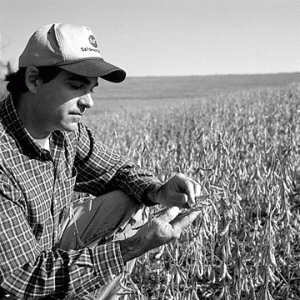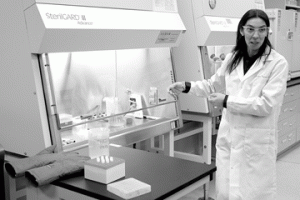Biofuels: Local Gives Way to Large Scale
By Bill Kovarik

In spring 2010 researchers with the University of Tennessee Biofuels Initiative planted 1,000 acres of switchgrass to evaluate the plant’s potential for use in the production of cellulosic ethanol at the Genera Energy/DDCE demonstration scale biorefinery at Vonore, Tenn. Photo by S. Jackson. UTIA.
ASHEVILLE, N.C. – Melita Kyriakou watches as a big blue fuel truck with a green biodiesel logo grinds past the fuel tanks, under the bridge and up the hill – off on another delivery to one of the four biodiesel retailers in the mountain city.
The good news, for Blue Ridge Biodiesel, is that they are still in business. The bad news is that half the staff has been laid off, and most other community-scale biodiesel plants in the state of North Carolina are going out of business.
“Its true – I do wake up in the middle of night,” she said. “There’s too much work, too little time, and too many forces against you.”
The biggest headache was the abrupt expiration of a $1 per gallon federal tax break in December, 2009. Attempts to extend the tax break could eventually succeed in Congress, but for now, biodiesel is quite a bit more expensive than regular diesel.
“Politicians are constantly talking about getting the country free of foreign oil,” Kyriakou said. “Yet here is one industry functioning, viable, directly plugged into the existing infrastructure—and it just had its legs cut out from under it.”
Before the end of the tax credit, the biodiesel industry employed an estimated 53,000 people, according to the National BioDiesel Board. No figures are available for the number of jobs lost so far.
“We just want a level playing field,” she said. “Local foods make sense—why not local fuel?”
Norman Smit of the Biofuels Center of North Carolina, says there is a place for small scale biodiesel. “There certainly is value in being able to convert (waste) into a commodity that can help school busses go,” he said. “The problem is that there isn’t enough of it, it isn’t particularly cheap to produce, and it can’t scale up.”
Replacing large amounts of petroleum is going to take large scale regional planning, he said.
Local fuel losing ground
Thirty years ago, in the wake of the Arab oil embargoes, the wildly popular idea was that farm and community scale efforts should replace foreign oil. Americans would band together, throw off the yoke of petroleum, and create healthy, sustainable jobs in their communities.
Thousands of small scale ethanol and biodiesel plants sprang up, including at least a dozen in the Appalachian region. Ribbon-cuttings and station openings provided regular fare for TV and newspapers, and communities took pride in reclaiming transport fuel technology and putting it under local control.
As late as 2002, most Midwestern corn ethanol plants were locally owned, and economic benefits spread through the communities, according to the Institute for Local Self Reliance (ILSR). But in recent years, a dramatic shift from small locally owned plants serving local markets to large plants serving distant markets has occurred.
“Thus, the close relationship between community and manufacturing facility was severed and the percentage of the dollar that stayed in the local community dropped significantly,” ILSR said in its 2008 Rural Power study. The study recommended re-orienting policy to favor local and rural renewable energy projects.
“From a technological perspective, larger may seem more profitable, but from a community perspective, smaller may be more profitable,” the study authors said. “As it turns out, the benefits of building big are small, while the benefits of building small are quite large.”
It’s ironic that state and federal policies often do just the opposite. Willis, Va., resident Sam Bolt discovered this in 2007 when he sold a few thousand gallons of extra farm-brewed biodiesel. Bolt was charged with tax evasion and given a one year suspended jail sentence. Although many were sympathetic, no one in government asked how they could help.
Region focuses on non-food crops

Biodiesel can be made from any fat or oil. Current U.S. biodiesel production is primarily from the oil from soybeans or from recycled restaurant cooking oil. Cleaner burning and renewable biodiesel is most often blended at 20% with petroleum diesel. Photo by Bob Allan, National Renewable Energy Laboratory
Only two large grain ethanol plants exist in the region. A Loudon, Tenn., plant built mostly for the corn sweeteners market in the 1970s produces 65 million gallons of corn ethanol per year along with many kinds of feed products from the leftover corn. Completed this year, Clean Burn Fuels, of Raeford, N.C., is producing about 60 million gallons of ethanol a year and delivering a daily ration of 18,000 bushels of distillers grains to the hog industry.
Most of the regional scale-up and commercialization of biofuels is focused on two new cellulosic ethanol fuel facilities.
• University of Tennesse at Knoxville, in partnership with Dupont Danisco and Genera Energy, will produce nearly 250,000 gallons of ethanol from an enzymatic process at a Biomass Innovation Park. Over 6,000 acres of switchgrass have been planted under contract with farmers in the region.
• Range Fuels in Soperton, Ga., is using waste wood from the paper industry to produce, at full capacity, up to 100 million gallons of ethanol and methanol a year. The wood is gasified and then converted to liquid fuels by a catalyst.
It is too early to tell how successful these efforts might be, but the resource base for biofuels from non-food sources has the potential to replace at least half of U.S. fuel consumption, according to a 2005 Oak Ridge National Labs study. Excluding grains—the second-generation cellulosic potential from perennial crops—farm and forest residues amount to over 1,200 billon tons of feedstock, which at 80 gallons per ton, would amount to just over 100 billion gallons of fuel, ORNL researchers said.
Impacts of Cellulose Biofuel Crops

Luciana Vergara shows off the fermentation lab on Friday, January 29, 2010 during the grand opening of the Cellulosic Ethanol Biorefinery in Vonore, Tennessee.
Switchgrass, miscanthus and other perennial biomass crops are very much like hay crops and seem to have few environmental drawbacks. According to a 2006 USDA study, benefits include “reduced soil erosion, increased water quality, enhanced soil-carbon sequestration, wildlife habitat and reduced greenhouse gas emissions.”
UT Knoxville researchers found that switchgrass can be left standing through most of the winter and can provide critical winter cover for wildlife.
Critics of the idea, like Timothy Searchinger of Princeton University, warn that forest and grassland will be converted to new cropland to replace the grain once grown elsewhere. Switchgrass, if grown on U.S. corn land, increases greenhouse gas emissions by 50%, he estimated.
“Searchinger’s argument … is flat wrong,” wrote C. Boyden Gray in a February Washington Times article. “He assumes mass conversion of forest land when the opposite is the case… Forest stocks have been stable, not falling, despite increased use of corn for ethanol. There has been no net conversion of land from sustainable forests to biofuel production.”
Like other facets of the “food or fuel” and biodiversity issues surrounding biofuels, the questions often involve future impacts, which are difficult to anticipate based on the limited experience to date.
A 2007 law—the Energy and Independence Security Act—requires that ethanol and other fuels have to produce fewer overall emissions of greenhouse gases over the life cycle of the fuel’s production, transportation and use. So far, according to the U.S. Environmental Protection Agency, the requirement has not proven overly difficult for the biofuels industry.
Biofuel’s future in Appalachia
The focus of research and development in the southeast has been to supply feedstock for the cellulosic ethanol industry, notes Jeremy Ferrell, Biodiesel Operations and Outreach Manager at Appalachian State University.
Yet the technology is not mature. “The promised breakthroughs in cellulosic ethanol technology, namely new lower-cost enzymes, have not yet come to fruition,” said Ferrell.
Along with large scale research into liquid fuels, small community-scaled biomass power plants (around 50MW) have proven successful, and there are many examples for the Appalachian region, Ferrell said. The McNeil Power Station in Burlington, for instance, uses waste wood, yard wastes and forest residues to create 50 MW of power while supporting a local forest industry.
ASU’s emphasis has been training, research and development for community-scale biomass technologies, such as BlueRidge Biofuels in Asheville, EnergyXChange in Burnsville, N.C., and the Jackson County Green Energy Park in Dillsboro, N.C.
Community technologies should include not only biodiesel, but also gasification, and
anaerobic digestion with raw materials such as agricultural and forestry residues, municipal solid waste, landfill gas, and used cooking oils.
Replacing even a percentage of petroleum will involve both small and large projects, Smit says.
“The key thing is that biofuels need to be sustainable and we need to have a discussion about it up front.”
“If the world switches from petroleum to bio-based materials, rural land is going to become a strategic asset, and biomass is going to become a major discussion point from policy and scientific point of view.”
From Green & Yellow to Simply Green
By By Maureen Halsema
“When you compare cost of biofuels to cost of petroleum it’s like comparing apples to oranges,” said Patrick Hatcher, executive director of the Virginia Coastal Energy Research Consortium. “The cost of petroleum is actually way under valued, because it is subsidized by the government and by the users. For example, one thing not incorporated into conventional fossil fuels, is the cost of abatement of the pollution. Look at the gulf crisis. Is the cost of fixing that going to go into the cost of petroleum? Probably not.”
While many other petroleum companies are investing hundreds of millions of dollars into algae research, BP has invested approximately $10 million into this next-generation biofuel.
Over the past several years, many executives left BP to become more involved in the research and development of algal biofuels and other green sector technologies.
Cynthia “CJ” Warner is one of those executives. After 20 years with BP, she left her position as head of global refining in February 2009 and is now the president of Sapphire Energy, a company based in California whose focus is the production of algal biofuels.
“I had an epiphany that if I was going to put so much personal energy into making something happen, it was a lot better to create the key to the future than to nurse along the dying past,” said Warner in an interview with Fast Company.
Other BP execs who have left in favor of greener technologies include: Lee Edwards, former president and CEO of BP Solar, left to work in biofuels at Virent Energy Systems; K’Lynne Johnson of BP’s Innovene division, who now leads Elevance Renewable Sciences to search for natural, sustainable alternatives to petrochemicals; and Janet Roemer, also of Innovene, who went on to head up Verenium, focusing on biofuels and enzymes.
Related Articles
Latest News

Leave a comment
Your email address will not be published. Required fields are marked *







Leave a Comment